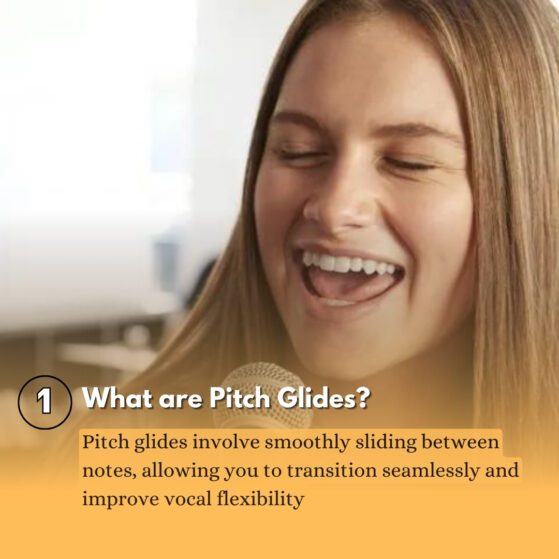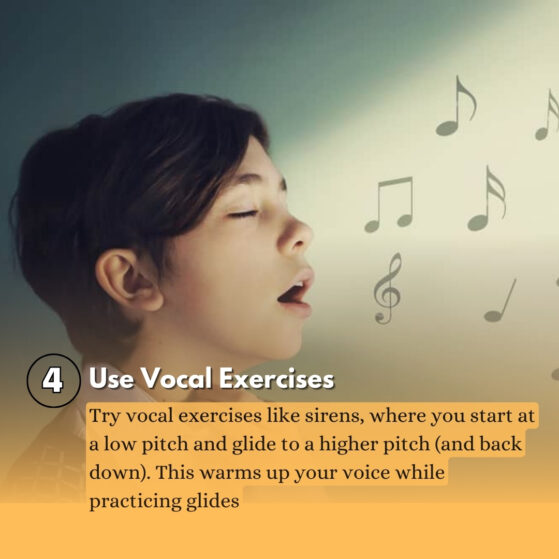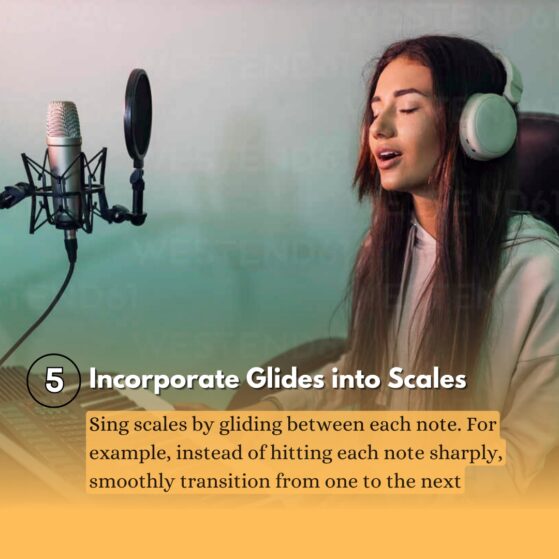Mastering Pitch Glides for Seamless Transitions
When it comes to singing, smoothness and fluidity can elevate a performance to new heights. One of the key techniques used by vocalists to achieve seamless transitions between notes is the pitch glide. Let’s explore this essential skill, how to practice it, and how it can enhance your vocal style.
What are Pitch Glides?

Pitch glides, also known as portamento, are a vocal technique that involves smoothly transitioning between two or more pitches without any interruption or distinct break between the notes. This technique allows singers to convey a range of emotions and styles, adding a unique flair to their performances. By mastering pitch glides, you enhance your vocal expressiveness and develop a more fluid vocal technique.
Pitch glides can be applied in various musical contexts, from classical and jazz to pop and R&B. They allow singers to move gracefully between notes, making them sound more connected and less mechanical. Think of the way a violinist slides between notes, creating a rich tapestry of sound; singers can achieve a similar effect with pitch glides, making their vocal lines more lyrical and expressive.
Why Practice Pitch Glides?

Practicing pitch glides is crucial for several reasons:
Developing Pitch Control: Regular practice of pitch glides helps you gain better control over your vocal pitch, which is essential for achieving accurate intonation in singing. This control is especially important in genres where subtle pitch variations are key to the style, such as in opera or jazz.
Enhancing Vocal Agility: As you practice gliding between notes, you improve your vocal agility. This means you’ll be able to navigate complex melodies and rapid sequences of notes with greater ease. Agility is essential for impressive vocal runs and ornaments.
Creating Expressive Performances: Pitch glides can significantly enhance your ability to convey emotion in your singing. The ability to smoothly transition between notes allows you to emphasize lyrical phrases and create dynamic contrasts, making your performances more captivating.
Improving Technique: Mastering pitch glides contributes to a more polished overall vocal technique. The smoothness and fluidity that come from gliding help eliminate tension in your voice, leading to healthier singing habits.
Stylistic Versatility: Learning to incorporate pitch glides into your singing opens doors to various musical styles. Whether you’re performing a soulful ballad or a fast-paced pop song, pitch glides can enhance your ability to adapt to different genres.
Start with Simple Slides

To embark on your journey of mastering pitch glides, start with simple slides between two nearby notes, such as C to D. This foundational exercise serves as a warm-up, helping you get accustomed to the feeling of sliding rather than jumping between pitches.
Steps to Practice Simple Slides:
- Find a Reference Note: Use a piano or keyboard to play your starting note (e.g., C). Sing the note, ensuring it is in tune.
- Slide Upward: From the starting note, gradually slide your voice up to the next note (D) without stopping or breaking the sound. Focus on maintaining an even tone throughout the glide.
- Reverse the Glide: After reaching D, slide back down to C. This repetition reinforces the sliding motion and helps establish muscle memory.
- Increase the Range: As you become comfortable, try gliding between other pairs of notes, gradually increasing the distance between them to challenge yourself.
Use Vocal Exercises

Vocal exercises are instrumental in developing your pitch glide technique. One particularly effective exercise is the “sirens” technique, where you produce a continuous sound while moving through a range of pitches, similar to the sound of a siren.
Sirens Exercise:
- Start at a Low Pitch: Begin by humming or singing a low note, allowing your voice to resonate comfortably.
- Glide Upward: Gradually slide up to a higher pitch, aiming for a smooth, connected sound. Focus on relaxing your throat and maintaining an open sound.
- Slide Back Down: After reaching the highest note, glide back down to the starting pitch. This downward motion is just as important for balancing your vocal range.
- Explore the Range: Experiment with different starting pitches and ranges. Aim for a smooth transition throughout the entire range, avoiding any cracks or breaks in your voice.
This exercise warms up your vocal cords while practicing glides, helping you build confidence in your ability to navigate pitch changes seamlessly.
Incorporate Glides into Scales

Once you’re comfortable with simple slides and vocal exercises, it’s time to incorporate glides into your scales. This practice will reinforce the idea of fluidity and connection between notes.
Steps for Glide Scales:
- Choose a Scale: Select a scale you are familiar with, such as the C major scale.
- Glide Between Notes: Instead of singing each note distinctly, practice gliding between each note. For example, when moving from C to D, slide rather than jumping.
- Focus on Smoothness: Pay attention to the smoothness of your transitions. Ideally, there should be no breaks or pauses; the movement should feel natural.
- Use Variations: Try gliding between different scales, such as minor or pentatonic scales, to expand your vocal flexibility.
Incorporating glides into your scales not only improves your technique but also prepares you to use gliding in your musical repertoire effectively.
Experiment with Different Vowel Sounds

Another effective method for refining your pitch glide technique is to practice using different vowel sounds. Each vowel has unique tonal qualities that can affect your vocal resonance and control.
Vowel Sounds Practice:
- Select Vowels: Choose a few vowels, such as “ah,” “ee,” and “oo.”
- Glide on Vowels: Sing a simple scale or glide between notes using just one vowel at a time. For example, slide from C to D while maintaining an “ah” sound.
- Observe the Differences: Notice how each vowel affects your pitch glide. Different vowels will resonate differently in your throat and mouth, influencing the overall sound.
- Combine Vowels: Once you feel comfortable with individual vowels, experiment by combining them within a single glide. For example, glide from “ah” to “ee” while transitioning through a pitch.
This exercise not only enhances your control but also enriches your vocal tone, helping you discover a wider range of vocal colors.
Record Yourself

Self-assessment is a vital part of the learning process, and recording your practice sessions can provide invaluable feedback. By listening back to your recordings, you can identify areas for improvement and track your progress over time.
Recording Tips:
- Set Up a Recording Device: Use your phone or computer to record your pitch glide exercises. Ensure that you are in a quiet space to capture the best sound quality.
- Record Different Exercises: Record a variety of exercises, including simple slides, sirens, and glide scales. This variety will give you a comprehensive view of your progress.
- Listen Critically: After recording, listen back and assess your smoothness, accuracy, and overall sound. Pay attention to any noticeable breaks or inconsistencies in your glides.
- Make Adjustments: Based on your observations, make adjustments to your technique in future practice sessions. Focus on areas that need improvement while celebrating your progress.
This reflective practice can be incredibly motivating and will enhance your overall learning experience.
Be Patient and Consistent

Lastly, remember that mastering pitch glides is a gradual process that requires patience and consistent practice. Improvement takes time, so it’s essential to cultivate a positive mindset and enjoy the journey.
Tips for Consistent Practice:
- Create a Practice Schedule: Set aside specific times each week to focus on pitch glide exercises. Consistency is key to making progress.
- Incorporate Glides into Daily Warm-Ups: Make pitch glides a regular part of your vocal warm-up routine. This will help reinforce your technique and make glides feel more natural.
- Set Realistic Goals: Set achievable goals for your practice sessions, such as mastering a specific glide or improving the smoothness of your transitions. Celebrate small victories along the way.
- Stay Motivated: Remind yourself of the benefits of mastering pitch glides and how they can enhance your vocal performance. Consider joining a vocal group or working with a vocal coach for added support and accountability.
By being patient and consistent, you’ll see significant improvements in your pitch glide technique, leading to more seamless transitions and a more expressive singing style.
In conclusion, mastering pitch glides is an invaluable skill for any singer looking to enhance their vocal artistry. By dedicating time to practice, experimenting with different techniques, and maintaining a positive attitude, you can achieve seamless transitions that elevate your performances to new heights. To further your vocal journey, consider enrolling in our Western Vocal Lessons Online, where you can master Western vocals from basic to advanced levels. So, warm up those vocal cords, embrace the journey of discovery, and let your voice soar through the beautiful world of pitch glides!








